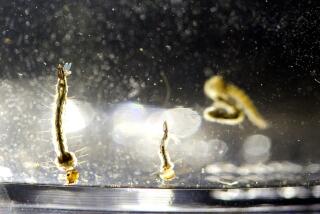Iraqis Admit to Broad, Virulent Germ War Plan
WASHINGTON — In their most comprehensive disclosures about biological weaponry, Iraqi scientists have admitted to conducting groundbreaking research on viruses that make eyes bleed and cause lethal diarrhea in infants and on toxins that can eliminate entire crops, U.N. investigators and U.S. officials said Tuesday.
Iraq’s program, which is turning out to be one of the most extensive in the history of biological warfare, included work on viruses and toxins ranging from yellow rain and camel pox to toxins that produce gangrene.
“No country I know of has ever even played with the idea of developing many of these into instruments of war,” a senior U.N. scientist said. “It represents highly innovative thinking and a very huge investment.”
Iraqi scientists, seeking to threaten civilians as well as troops, also worked out a novel way to make their deadly or debilitating germs rain down on wide areas, the sources said. They modified “drop tanks,” originally designed as auxiliary fuel sources for warplanes, so that they could spray biological agents over a region from high altitudes.
The initial targets now appear to have included Israel as well as regional rivals and any opposition troops mobilized against Iraq after its invasion of Kuwait in 1990. Israel was a target in part because of its 1980 bombing of an Iraqi nuclear reactor, the Iraqis told the U.N. inspectors.
Iraq says it dismantled the program following its defeat in the 1991 Persian Gulf War, a claim that U.N. inspectors must now verify.
Iraqi officials revealed the dimensions of the program, which is proving far more ambitious than Western intelligence and U.N. arms inspectors had expected, to U.N. investigators last week. Until then, Iraq had claimed that its program employed only 10 people who wrote six research papers on biological warfare over a four-year period.
But U.N. investigators now say the biological weapons program involved up to 150 scientists and senior technicians, not including support staff, security personnel and other aides.
The germ warfare program, well under way during the 1980-88 Iran-Iraq War, moved into an even more intensive phase in July of 1990, a month before the invasion of Kuwait that eventually triggered the Gulf War.
Despite its extensive testing of biological weapons, Iraq is not known to have used them during the Gulf War largely because of U.S. threats of severe retaliation.
Iraq, however, had repeatedly used chemical weapons both in the war with Iran and later against its own northern Kurdish community. Up to 5,000 Kurds were killed by chemical agents when Iraqi troops used them in Halabjah.
The disclosures are the latest from Iraq since its top arms procurer, Lt. Gen. Hussein Kamel Majid, defected last month. In a preemptive bid to keep his revelations from discrediting them, Iraqi officials began revealing the full dimensions of their nation’s program after lying for almost five years, U.N. and U.S. sources said.
Some of the germs under development by Iraqi scientists were intended not to kill but to seriously incapacitate enemy troops, sources said. Iraq was apparently working on the theory that Western nations, which put a high premium on human life, would take longer to care for the sick and the injured than to bury the dead.
“Incapacitating agents can cause a bigger drain on forces, as they have to tend to the wounded, which diverts attention and resources,” said Charles Duelfer, deputy director of the U.N. Special Commission that is investigating Iraq’s nuclear, chemical and biological weapons programs.
Among the viral agents, U.N. specialists said, was one that causes hemorrhagic conjunctivitis, which at minimum causes temporary blindness and in the worst case causes the eyes to bleed. The onset is within 24 hours, and the virus is highly transmissible.
Another was a virus that causes chronic diarrhea that can be lethal in children and incapacitating to troops. A third was camel pox, which, like smallpox and monkey pox, produces lesions. None of the three has ever been used in biological warfare, the U.N. scientist said.
The Iraqis also considered making two other viral agents, those that cause yellow fever and the Crimean Congo hemorrhagic fever, the latter a tick-borne disease common to the Crimean Sea area and the region of the Zaire River formerly known as the Congo.
The Iraqis did produce more than 78 gallons of the bacterium that causes gangrene, a common infection in wartime wounds, the U.N. specialists said. They were experimenting with spreading it through aerosol devices that would allow the spores to penetrate the lungs and with weapons releasing shrapnel that would open wounds in the skin for spore penetration.
Among the mycotoxins--those produced by fungi--sources said Iraq admitted to producing yellow rain, also known as T2, which the Soviet Union was accused of using in Southeast Asia and Afghanistan. It can cause the lungs to bleed and usually kills.
The deadliest plant toxin produced by Iraq was ricin, which is made from beans of the castor-oil plant. Iraq has a large plant at Al Fallujah currently making castor oil from plants--supposedly for brake fluid, U.N. scientists said.
Iraq may have intended to use ricin if necessary during its war with Iran, U.N. scientists said. Although Iraq never loaded many of its newly revealed viruses and toxins into delivery systems, it tested at least one 155-millimeter artillery shell loaded with ricin.
In the most notorious use of the toxin, Bulgarian dissident and defector Georgy Markov died in London in 1978 after he was shot with a ricin-poisoned pellet fired from an umbrella.
Perhaps the most unusual biological agent tested in the Iraqi laboratories was the wheat-cover smut, which produces a purplish-black growth on the grain stem and ultimately kills the entire plant.
Of all the weapons of mass destruction, U.N. investigators say they are most worried about biological weapons because they would be the cheapest and easiest to reproduce even if Iraq has dismantled its program.
More to Read
Sign up for Essential California
The most important California stories and recommendations in your inbox every morning.
You may occasionally receive promotional content from the Los Angeles Times.










